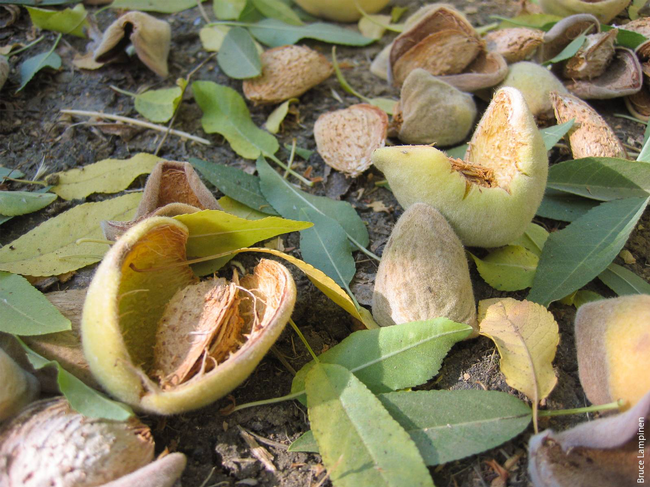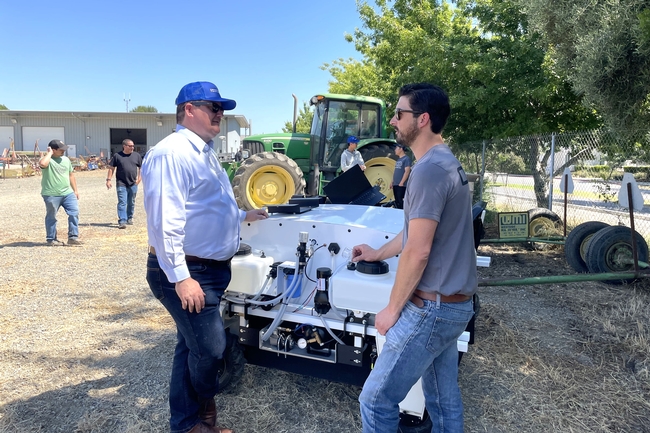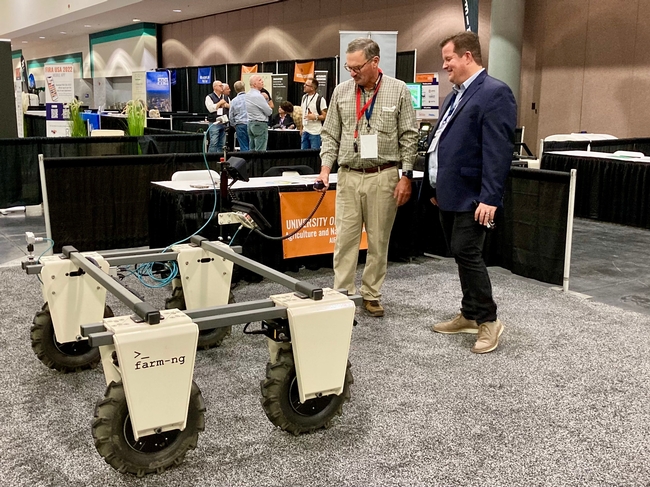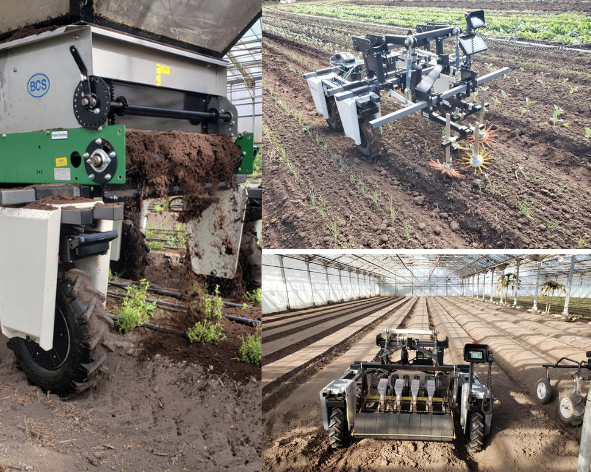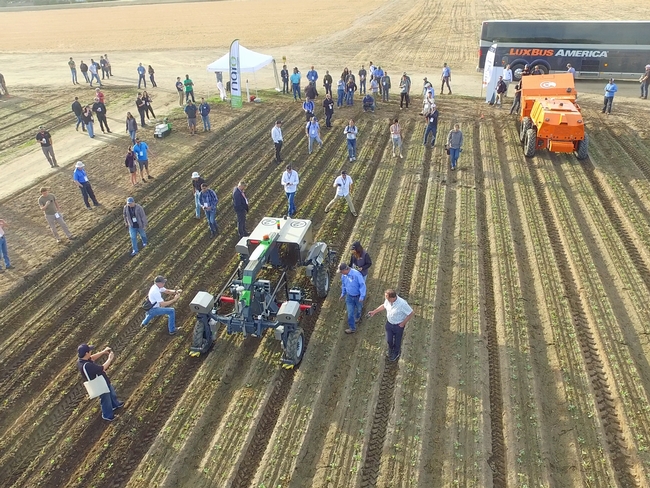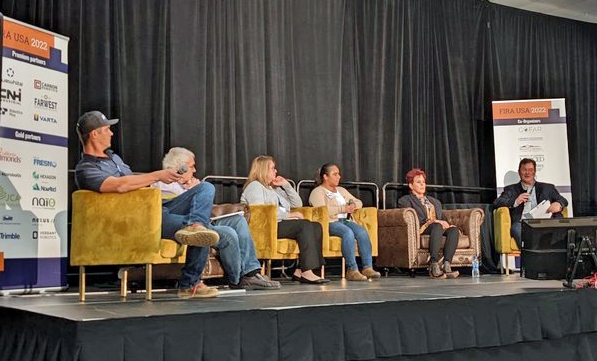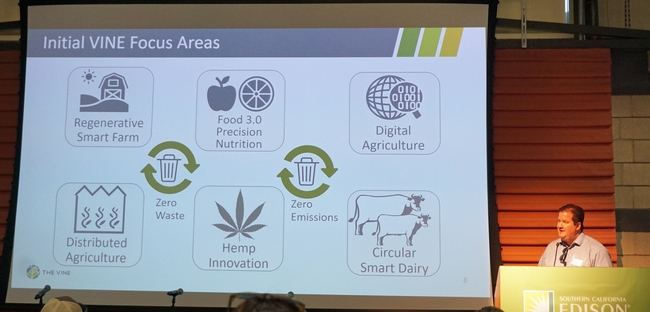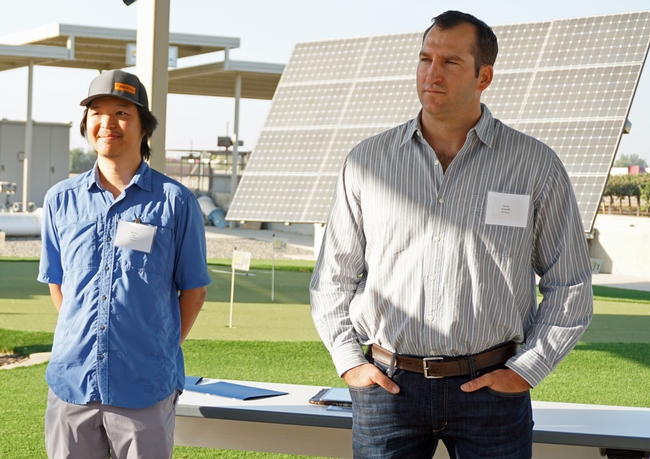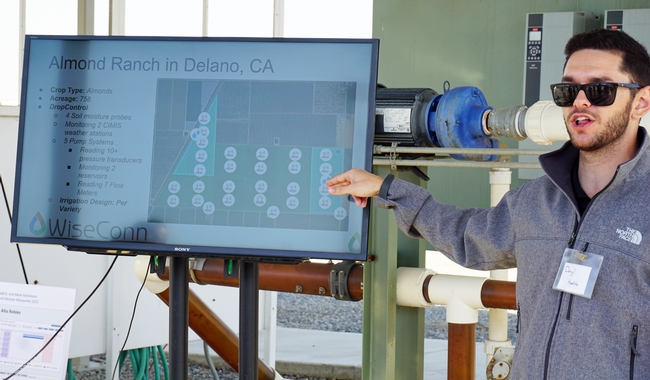Posts Tagged: Gabe Youtsey
New project aims to use farm waste to fuel bioeconomy
UC ANR to help create database, support technology for sustainable bioproducts and biofuels
In California's Northern San Joaquin Valley, crop leftovers such as almond shells, fruit peels and orchard trimmings can potentially be converted into sustainable bioproducts and biofuels – with the right technology. The philanthropy Schmidt Sciences' Virtual Institute on Feedstocks of the Future, which supports replacing fossil feedstocks with renewable biomass sources, has awarded new funding to a group investigating how to make better use of the diverse agricultural waste in the region.
“This is an important project for California as it quantifies the diverse ‘ingredients' in the North San Joaquin Valley available to fuel the emerging biomanufacturing industry in the state,” said Gabe Youtsey, chief innovation officer for the University of California Agriculture and Natural Resources. “This foundational work will kickstart a completely new innovation bioeconomy in the Central Valley that will create new high-paying jobs for our communities and support a resilient food and agriculture industry through circular biomanufacturing.”
Circular biomanufacturing is a process that uses waste streams as raw materials to create new products.
“Circular means taking waste streams from agriculture such as almond shells or grape pomace, forest waste or food processing waste and using that material as the ‘feedstock' in a fermentation tank to create new bioproducts,” Youtsey explained.
The group, “Building the Circular Bioeconomy in the North San Joaquin Valley” or BioCircular Valley, is co-led by the Department of Energy's Lawrence Berkeley National Laboratory (Berkeley Lab), UC Berkeley, and BEAM Circular, with partners at UC Merced, UC Agriculture and Natural Resources, the Almond Board of California and USDA Agricultural Research Station in Albany.
“California has this incredible diversity of materials, but they aren't well understood – and this makes it difficult to know how to extract the most value out of them,” said Corinne Scown, a senior scientist at Berkeley Lab and UC Berkeley and one of the project leads. “We want to characterize them and make that information available so companies can more easily figure out which feedstock is a good match for them, and then use that agricultural residue to make everything from bio-based polymers and chemicals to sustainable materials and aviation fuels.”
One of the group's goals is to build a publicly accessible database and user-friendly map full of information about different feedstocks, the raw plant materials and biomass that can be broken down and used to make bioproducts. That includes where feedstocks are located, when they are available, how they are currently disposed of, how they perform in different bioreactors, how much sugar or lignin they contain, whether they can be processed with other feedstocks, their greenhouse gas footprint, the potential cost, and much more.
UC ANR's role is to collect data on available feedstocks from forest, agricultural and food processing byproducts, as well as municipal waste streams through sampling and observation.
“We will do this through the extensive knowledge and relationships we have with the California agriculture industry in the North San Joaquin Valley,” Youtsey said. “UC ANR will also support industry outreach as new ‘conversion' technologies are developed, to pilot them with California growers and processors.”
The project will also test ways to improve the flexibility of the conversion process, which breaks down feedstocks to prepare them to make bioproducts. Researchers will apply artificial intelligence to their lab-generated data to improve predictions of how feedstocks can be processed most efficiently or blended together. Being able to use the same technique on different (or mixed) kinds of plant matter would open up ways for companies to make bioproducts more easily.
“Our region has a fantastic combination of diverse and large-scale agricultural activities alongside manufacturing expertise, making this a great place to scale up bioeconomy innovation,” said Karen Warner, CEO of BEAM Circular. “This project will allow us to reduce barriers to using our region's abundant waste streams in more sustainable and valuable ways, so that we can create the products that people need with renewable inputs that are better for the planet.”
The project builds on ongoing efforts to establish biomanufacturing capabilities in the northern San Joaquin Valley, which includes San Joaquin, Stanislaus and Merced counties. Providing better data on how to convert the valley's millions of tons of agricultural waste into valuable products may spur biomanufacturing companies to build facilities nearby, minimizing how far the raw materials have to be moved and generating new jobs.
“This project is designed to benefit a region that has massive potential, but so far has been economically left behind, and to develop a new industry that can provide improvements in air quality, water quality and greenhouse gas emissions as well as significant opportunities in economic equity and the creation of new jobs,” said Blake Simmons, director of Berkeley Lab's Biological Systems and Engineering Division and the BioCircular Valley project lead.
“This kind of research started as basic science, and now we're bringing information and solutions to people who can use them. And the knowledge generated through this project will advance not only the ability of the NSJV to make use of its own regionally available future feedstocks, but will also accelerate the understanding of feedstocks relevant across California and across the U.S.”
The new funds for the project come from the Virtual Institute on Feedstocks of the Future, a partnership between Schmidt Sciences and the Foundation for Food & Agriculture that supports collaboration on research to transform biomass into alternative feedstocks for biomanufacturing. The award is one of five announced today, which total $47.3 million over five years. It is expected that the five teams will collaborate to share best practices and knowledge to boost the bioeconomy at the national level.
“We are grateful for Schmidt's generous support that will help deploy advanced technologies on the ground,” said Alicia Chang, interim president of Berkeley Lab Foundation. “The foundational research and expertise developed through work for the Department of Energy sets the stage for this team to apply their capabilities to bring jobs and lift the community and the economy in the Northern San Joaquin Valley.”
The VINE announces call for startups to apply for field-trial support
Validation of Innovation Program provides supportive ecosystem for startups
The VINE, an initiative by the University of California Agriculture and Natural Resources, is now accepting applications for its VINE Validation of Innovation Program. The program aims to support innovation in the agri-tech sector, particularly in climate-resilient solutions for California food systems.
Made possible with support from a UC Climate Action grant, the program is inviting startups to apply, with a focus on providing comprehensive support for field trials – a critical stage for any agri-tech venture.
"Field trials are vital for validating new innovations in the agri-tech sector,” said Gabe Youtsey, chief innovation officer with UC ANR and founder of The VINE. “The VINE VIP aims to provide a supportive environment for carrying out these essential tests, bridging the gap between innovative concepts and real-world application."
Elif Ceylan, co-founder of OpenGate Partners and head of the VINE VIP, also stressed the importance of field trials.
"Field trials serve as a crucial phase where promising ideas either succeed or require adjustment,” Ceylan said. “We are committed to prioritizing this stage to ensure the effectiveness and relevance of emerging agri-tech solutions."
The VINE VIP offers more than field trials. It provides a supportive ecosystem for startups, including industry connections, access to a broad network of farmers and experts, comprehensive validation results and market entry support. The program is a unique accelerator that pairs startups with project partners in the agri-tech industry, facilitating Proof of Concept projects and commercialization trials for industry-defined challenges in California agriculture.
By connecting startups with farmers, academics and industry experts, the program aims to validate, advance, adopt and amplify innovative technologies, reducing technological risks and accelerating sales through its extensive industry network.
Startups interested in joining the VINE VIP can apply until Sept. 16, 2023. Detailed information about the program and the application process is available on The VINE's website at thevine.io/vip.
The VINE is an initiative of the University of California Agriculture and Natural Resources, dedicated to fostering agriculture, food, and biotech innovation in California. Our mission is to support industries and entrepreneurs while promoting technology innovation and commercialization for sustainable and equitable food systems. We connect entrepreneurs with public and private sector resources, encourage collaborations to address industry challenges, and promote regional capacity for global innovation as an economic opportunity.
Farm robotics competition challenges students to solve real-world problems
College students are invited to develop a robot that makes farm work easier while competing for cash prizes and bragging rights in the Farm Robotics Challenge, a three-month robotics development competition running from Feb. 1 to May 13, 2023.
The challenge is being sponsored by The VINE, an initiative of the University of California Agriculture and Natural Resources focused on agricultural innovation, in partnership with the AI Institute for Next Generation Food Systems (AIFS), farm-ng robotics company, and the Fresno-Merced Future of Food (F3) Innovation coalition.
"Our primary objective for the Farm Robotics Challenge is to empower young innovators to explore careers in agriculture technology and innovation," said Gabe Youtsey, chief innovation officer for UC ANR and head of the VINE. "The agrifood technology industry is one of the most exciting and fastest-growing sectors in the economy right now, estimated to reach $30.5 billion by 2050. Yet, because of a lack of exposure or access, our brightest minds end up entering other sectors, taking their talents and abilities with them. We hope this new competition changes that and reverses the talent flow back into agriculture."
“In order to have a next-generation food system, we need next-generation agricultural robotics developers,” said Steve Brown, AIFS associate director. “There is tremendous innovation potential in this domain that just needs more connecting points to the coders and makers.
The Farm Robotics Challenge is open to any university or college in the U.S. Student teams will be asked to address a production farming topic on any crop or size of farm, with a desired focus on small farms, by automating an essential farm-related task using the farm-ng robotics platform. Each campus will need to purchase a farm-ng robot or borrow one to participate in the challenge.
Specific challenges will either be pre-identified for teams to choose from, or teams may choose to create additional or custom functionality to solve a self-identified challenge. Challenges will fit into one or more of the following categories: autonomy, artificial intelligence or attachment. Virtual training sessions will be offered throughout the competition to provide teams with expert guidance and technical help from AIFS, farm-ng, The VINE and other partners.
Student teams will be judged on the following criteria, with a grand prize and several specific prizes for top teams in each category: accuracy and completeness, market fit and commercial potential, design elegance and ease of use, cost-effectiveness, safety, interdisciplinary inclusion, and social and economic impact. Winners will receive cash prizes and connections to robotic companies for internships and jobs, among other benefits.
For more information, please visit the Farm Robotics Challenge website at https://farmbot.ai. If you have questions, contact HannaBartram, AI Institute for Next Generation Food Systems education and public engagement coordinator, at hcbartram@ucdavis.edu.
First FIRA USA Ag Robotics Forum attracts people from around the world
Agriculture and the global food supply is threatened by a range of issues including drought, climate impacts, increasing business costs and labor scarcity. To forge solutions to these issues and more, nearly 1,000 attendees from 26 countries converged in Fresno on Oct. 18-22 for the inaugural FIRA - World Ag Robotics Forum to be held in the U.S. The event was co-sponsored by UC Agriculture and Natural Resources' The Verde Innovation Network for Entrepreneurship, or the VINE.
Widely observed as a pivotal moment for agricultural technology and robotics in U.S. agriculture, the event was kicked off by California Department of Food and Agriculture Secretary Karen Ross and moved into a packed agenda with panel discussions, lightning talks and pitches where automation company representatives, academics and growers had the opportunity to share their challenges, concerns and hopes for the future of autonomous farming. The event culminated at CSU Fresno with more than a dozen companies offering in-the-field demonstrations.
Although growers are the target market for most of the equipment, the benefits of automation can ripple out into society, according to Glenda Humiston, University of California vice president for agriculture and natural resources.
“Technology can help us grow, harvest and distribute food more efficiently so that it can become more affordable and accessible for those who are food insecure,” said Humiston. “If we do this right, it's good for the whole community.
Here are a few themes and takeaways from this pioneering multi-day event.
Gaining on-farm use - Focus on end-user needs and ease of use
A major question speakers tackled was why more growers aren't yet integrating automation on their farms. Automation solutions exist and are being developed to help growers in nearly every aspect of running a farm — from planting, harvesting and weeding to addressing persistent labor shortages. Despite this, ag automation companies – both big and small – still face resistance from growers to adopting new technologies.
Part of the problem, Jeff Morrison of Grimmway Farms said during a panel on mechanization versus automation, is that companies pay more attention to their product than the needs of the grower. “Farmers want technology that fills a particular need,” he said. Anna Haldewang, the founder of InsightTRAC, agreed. “Don't be married to your product, be married to your customer.”
Chuck Baresich, president of the Haggerty AgRobotics Company, emphasized the importance of creating automation solutions that are simple and intuitive to use. “For a manufacturer, the first thing I'd tell them is don't overcomplicate things,” he said. “Make sure your robot can drive straight, start with that.”
Panels also touched on the technical, business and regulatory challenges to automating agriculture. The ag tech startup market is much younger than Silicon Valley, and we don't yet know the best route to establishing a successful business, Rob Trice of Better Food Ventures and The Mixing Bowl observed during a panel on robotic product development with key industry leaders, including Walt Duflock, vice president of innovation for Western Growers. That said, panelists identified three things that startups should do:
- Get prototypes into the field as quickly as possible to get performance data and get feedback, including from farmworkers, who may come up with multiple uses for the product.
- Be transparent about development to build partnerships with investors and growers. Partners understand that startups are a work-in-progress.
- Be ready to evolve and change your technology or your business to meet the customers' needs. Love the customer, not the tech.
AgTech, Labor and Farmworkers - Forging win-win opportunities
Labor issues also emerged as a persistent theme during the event. One of the major forces driving the need for automation in agriculture is persistent labor shortages. Simply put, farmers do not have sufficient labor to sustain their operations and are turning to agtech, robotics and automation to fill the gap. At the same time, as robotics and automation take hold in the agriculture industry, farmworkers and farm labor organizations are rightly concerned about the impact that the adoption of automation will have on agriculture jobs, in particular farm labor jobs.
Hernan Hernandez of the California Farmworker Foundation acknowledges the labor concern, but also sees opportunity. “All of a sudden, you go from 100 individuals that are going to be able to harvest this season to now 10 that will harvest with a machine," he said. "But the way we look at it is as well, when we talk to farmworkers and engage them, and we look at data, there is also opportunity. We know a lot of the farmworkers want opportunities to further their skill sets.”
We've got to find ways to help our farm workers actually get the training they need to make use of this technology, which will give them a better quality of life.
This sense of optimism about the future of the farmworker was shared by Gabe Youtsey, chief innovation officer of UC ANR, who moderated a panel on the future of agricultural work. “California as a whole has begun recognizing the importance of creating the next generation of ag workers,” he observed, “and schools and industry have both taken notice.” Indeed, California community colleges have begun working on new relevant programs that translate directly to jobs, and the federal government has allocated $10 million going directly to Central Valley agricultural education and workforce development programs.
What's next?
The gathering also served as a platform for launching new technology initiatives. Youtsey, in collaboration with our partners at UC Davis AI Institute for Food Systems, announced the 2023 Farm Robotics Challenge at FIRA USA 22! We look forward to co-hosting this event!
It is clear that automation and robotics will play an increasingly crucial role in agriculture. Not only in addressing the pronounced labor shortage in agriculture, but by creating new value creation opportunities related to resource efficiency, crop health, disease, harvesting and more.
“Our job at The VINE is to drive collaboration between industry, academia and government forward,” said Youtsey. “Robotics is moving very fast and there's a new set of players coming into the space. UC Cooperative Extension advisors can bring startups and farmers together in creative new ways during development and advance these solutions into commercialization faster.”
Co-sponsors of the conference included FIRA, Western Growers, University of California, Merced, California State University, Fresno and the Fresno-Merced Future of Food (F3) Innovation Initiative.
Industry sponsors included Bluewhite, Carbon Robotics, CNH Industrial, Far West Equipment Dealers Association, Grimmway Farms, Keithly-Williams Seeds Inc., Robotics Plus, VARTA AG, and Sonsray Machinery, LLC.
For more information
- Subscribe to the FIRA Newsletter HERE and check the website for future events.
- Interested in the 2023 Farm Robotics Challenge?Learn more at https://farmbot.ai.
Farming technology focus at Open Farm 2019
From robot vacuum cleaners and doorbell cameras to social media and e-commerce, technology is continually transforming lives and businesses. The world's oldest industry – agriculture – is no exception.
Remote sensors are all but eliminating the need for farmers to walk plant rows and make decisions based solely on observations, experience and intuition. New technologies that gather and analyze data can optimize crop needs, reduce environmental impacts, increase efficiency, cut energy costs and save water. The latest innovations were on display at the fourth annual Open Farm conference Oct. 23 in Tulare.
A demonstration by PowWow Energy showed artificial intelligence technology not only improving farming, but also spinning off new ideas and local businesses in rural communities. PowWow supports farms who have solar panels with information to optimize their return on investment. By monitoring weather, utility rates and meters, and the panels' energy generation, the company calculates precisely when energy losses caused by dust on the solar panels are valued higher than the cost of cleaning them. When it's time to wash the panels, farmers receive a text notification.
That got Tulare County dairy farmer Justin Roeloffs thinking about the growing need to efficiently clean dust from solar panels. He built a solar panel cleaning system that was so effective, he started a business – Roeloffs Solutions – to offer panel cleaning to other solar owners, creating new jobs in the farming community.
“The almond season is a disaster for solar panels,” Roeloffs said. “Some farmers buy a kit and do it themselves, but we had many calls for our service the first month in business.” Last summer, Roeloffs Solutions cleaned panels that generate 30 megawatts of power.
The founder of Concentric Power, Brian Curtis, explained the business he built to manage the energy usage and needs of large food processors, beginning in the Salinas Valley. The system allows businesses to save money on their energy bills, maximize the use of renewable energy and maintain reliable energy availability, even during blackouts and brownouts. Concentric Power combines wind, solar, co-generation and battery storage to develop a company's own micro-grid.
“The recent public safety power shutoffs are ringing our bell,” Curtis said. “The stars have aligned for us.” So far three Salinas Valley food processors and one in Bakersfield have installed the micro-grid systems. Curtis said energy intensive ag industries – such as dairies, cheese processors and wine producers – are potential clients.
A variety of other automation solutions were also shared at Open Farm:
- Darryl Hadlich of WiseConn said the company's precision irrigation timing system – monitored by infield sensors and controlled by in-field nodes – allows farmers to schedule, start and end irrigation and fertigation using their cellphones or desktop computers. The associated software also shows when energy companies offer lower, off-peak rates to enable irrigation scheduling when the cost to operate the pump will be at its lowest.
- Conner Kingman of Kingman Ag Service is perfecting technology to reconfigure the tractors farmers already own with artificial intelligence-aided computers to pull a wide variety of farm implements through the field, such as a spring tooth cultivator, mower, shredder and sprayer. The driverless tractors reduce labor needs, and enable farm work to continue around the clock without breaks or worker safety concerns.
- Jose Baer at PowWow Energy detailed programmable irrigation systems for small and large farming operations. The field is monitored with aerial images and uses data from in-field sensors for targeted water application.
- John Cardoza of Sustainable Conservation explained a collaborative research project that studied methods for dairy wastewater management using sensors, sand media filters and drip irrigation. In the study, nitrous oxide emissions were cut by 70%, water use by 36% and nitrogen applications by 45%.
During a researcher and industry panel on the state of technology integration from the grower's perspective, participants reflected on how technology will help prepare for the future. The panel was moderated by Dennis Donahue, director of Western Growers Center for Innovation and Technology:
- Director of the Tulare County Resource Conservation District Mike Chrisman, a long-time Tulare County farmer, noted that data will be increasingly critical for farming as California agriculture enters the Sustainable Groundwater Management Act era in 2020. The law requires that California groundwater usage be “sustainable” by 2040 – meaning that the amount that is drawn out must match the amount that is recharged. “This will change the way we all do business,” Chrisman said. “Agriculture in 20 years won't look like it looks today.”
- Jeff Dahlberg, director of the UC Kearney Agricultural Research and Extension Center and a sorghum extension specialist, said high technology companies will rely on UC researchers to confirm that their products are meeting expectations. UC scientists can contribute by applying their knowledge on plant growth and development. “We understand biology and how plants use water,” he said. “We will be asked to ground truth technology.”
The event is a collaborative effort by UC Agriculture and Natural Resources, Fresno State's BlueTech Valley, the California Energy Commission, PowWow Energy, West Hills College and the Western Grower Center for Innovation and Technology. Open Farm 2019 was hosted at the Southern California Edison Energy Education Center.

